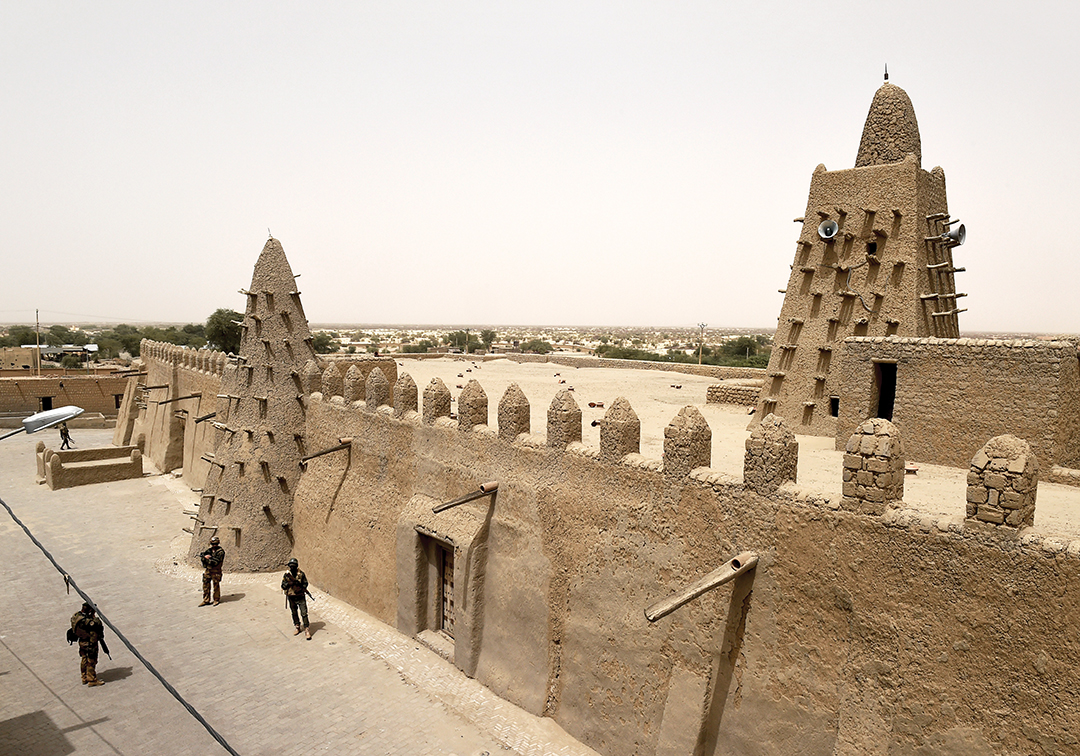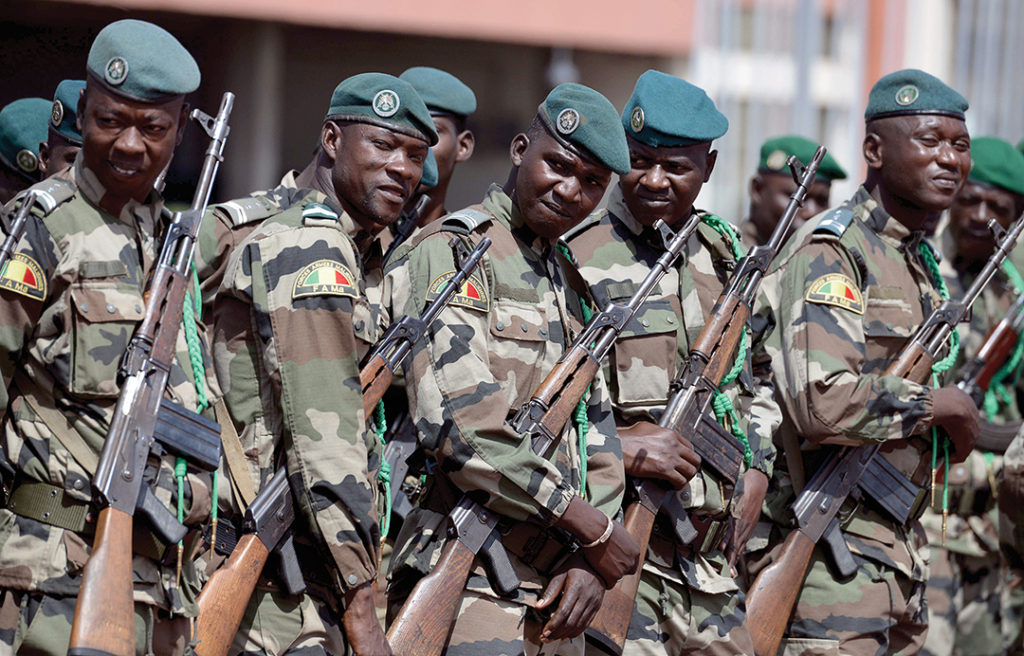The country works with neighbors and international organizations to stifle extremists and stop recruitment
LT. MOHAMED KEITA/NATIONAL GENDARMERIE SCHOOLS COMMAND
Photos by AFP/GETTY IMAGES

Reducing violent extremism in Mali seems technically and tactically uncertain, owing to the complexity of regional politics. This is marked by an increasing number of players and stakeholders whose interests compete more often than they align.
Since 2012, the number of armed groups in Mali has increased, and the spread of intercommunal violence is jeopardizing the Algiers’ Comprehensive Peace and Reconciliation Agreement (CPRA). Terrorist cells have proliferated throughout the country as the threat’s epicenter has moved from northern Mali to the center and the south, with sporadic attacks in the Mopti, Koulikoro and Sikasso regions.
These attacks have targeted security posts and local administration facilities. The capital, Bamako, has not been spared. Terrorists move throughout the Sahel region, and Mali’s national boundaries are still porous despite an international presence since 2013, notably through the United Nations Multidimensional Integrated Stabilization Mission in Mali (MINUSMA). Also deployed are personnel from the French military, who are engaged in Operation Barkhane, and the European Union, the African Union and the United States.
In such a volatile environment, knowing the enemy is necessary but not sufficient. Today, knowing how to collaborate with allies and coordinate agendas is crucial. The best way for the Malian government to coordinate all regional and international initiatives for the Sahel is to develop a holistic national strategy to combat terrorism and violent extremism.
The Malian government’s top security challenge is to make and consolidate peace with the former separatist Azawad movements of the north through the CPRA. This is necessary to preserve the territorial integrity of the country, protect core constitutional values and restore the state’s full authority. The government’s second-most-important challenge is terrorism and violent extremism.

To understand the scope of terrorism and violent extremism in Mali, it is important to explore its nature and dimensions.
Terrorism in Mali is based on a violent interpretation of the Quran and the call for jihad against the “unfaithful” and their allies. Indeed, terrorists’ goals in the Sahel and Mali are to combat Western values and African “puppet governments” to, ultimately, create an Islamic state, or a caliphate, that would be ruled by Sharia.
Terrorism in Mali is transnational and local. The three largest transnational terrorist groups in Mali are al-Qaida in the Islamic Maghreb (AQIM), the Movement for Oneness and Jihad in West-Africa (MUJAO), and al-Mourabitoun, created by Mokhtar Belmokhtar. In 2016, the latter was more active than the first two as it claimed responsibility for attacks in Mopti, Menaka and Gao against MINUSMA, Malian Armed Forces and the French Operation Barkhane. The group also attacked the Radisson Blu Hotel in Bamako in November 2015 and the Hotel Nord-Sud in March 2016, the site of the headquarters of the European Union Training Mission in Mali.
The key example of local terrorism in Mali is Ansar al-Dine, whose combatants are predominantly Tuaregs. Led by Iyad Ag Ghali, Ansar al-Dine’s political and ideological agendas are more focused on Mali than on global issues. It has a strategy of spoiling the ongoing peace process, which runs counter to the group’s interests, as well as extending an extremist ideology to the rest of the country. To achieve this, Iyad Ag Ghali created two affiliated cells in 2015: Katiba Ansar al-Dine Macina and Katiba Khalid Ibn Walid (Ansar al-Dine of the South).
Katiba Ansar al-Dine Macina is led by Hamadoun Kouffa, a former radical preacher of the Mopti region. Operating in the center of the country, the group is mainly composed of former MUJAO fighters and sympathizers. The other cell was led by Souleymane Keita, a former member of the Islamic police of Timbuktu created during the 2012 siege by AQIM and Ansar al-Dine. In June 2015, the group claimed responsibility for attacks on Malian military and administrative facilities in Fakola and Misseni, two villages of the Sikasso region near the border with Côte d’Ivoire. Keita was arrested in March 2016.
Transnational and local terrorist organizations have reorganized after being defeated by French and African forces in January 2013. They have become even more dangerous since January 2015, with subversive actions increasing against the Malian defense and security forces as well as international partners deployed to support Mali in its stabilization efforts. The United Nations has reported that the attacks are sophisticated, combining improvised explosive devices (IEDs) with mortar fire and ambushes.
A GOVERNMENT APPROACH TO EXTREMISM
The Malian government’s approach to counterterrorism and violent extremism is based on prevention and collaborative policing. The government is implementing a five-year preventive strategy called the Governmental Actions Program 2013-2018. It is aimed at addressing the root causes of the 2012 crisis, including insecurity in northern Mali, the disintegration of public institutions, rampant corruption, the degradation of living conditions and loss of moral values within society. The program consists of six strategic concepts:
- Establish strong, credible institutions.
- Restore security all over the country.
- Implement a national reconciliation policy.
- Rebuild the Malian school system, including revising the curricula and building modern infrastructure.
- Build a stronger economy.
- Implement an active social development policy.

To effectively counter radicalism and violent extremism, a Ministry of Religious Affairs and Worship was established in 2012. It is responsible for training imams and framing sermons. One major achievement has been the signature in 2013 of the Agreement for Islamic Cooperation with the Moroccan Ministry of Habous and Islamic Affairs. The aim of this “Islamic diplomacy” is to promote an enlightened way of practicing Islam based on tolerance. As a result, 500 Malian imams are expected to be trained in Morocco. As of late 2016, 200 had completed their two-year training in moderate Islam.
The new ministry also has collaborated with the Islamic High Council and the Malian Association of Imams to launch a counternarrative campaign called “Mali Kuma Kan,” or “Mali’s Voice.” It is aimed at undermining terrorist recruitment, especially among young people. One-minute videos are broadcast in local dialects on TV, YouTube and Facebook. They begin with shocking images of extremists terrorizing civilians. Then they show Malian religious leaders explaining how such actions violate the Quran. The videos end with a core message, such as, “In Islam, killing a human being is like killing all of humanity.”
SECURITY ON LOCAL AND REGIONAL LEVELS
Mali’s approach is mainly based on collaborative policing, which can be defined as law enforcement agencies, namely the police and gendarmerie forces/services, working together and cooperating with other allied units/partners/institutions, such as the National Guard or the Army. This collaboration can be at the national or regional level. A key focus of these efforts is building trust with the community to combat crime and foster confidence. At its best, community policing lets communities benefit from an improved policing service based on responsiveness, consultation, effective mobilization and problem solving.
As a response to the lack of clear leadership and coordination between security special intervention units during times of crisis, the Ministry of Security and Civil Protection (MSCP) adopted in December 2015 a Protocol for the Use of Special Intervention Units composed of the police, the gendarmerie, National Guard and Civil Protection. Thanks to that protocol, leadership becomes situational, and the distribution of responsibilities among these units becomes clearer when a crisis breaks out. Another innovative measure is the creation of the MSCP Centre for Operations as a core element of the protocol for crisis management. The center is responsible for designating an appropriate response unit and directing it to the area in need.
The protocol also contains a plan to secure Bamako to mitigate consequences of terrorist attacks. Protective measures have been taken, including identifying critical infrastructure, specifying units to protect certain installations, and installing monitoring cameras in sensitive areas.
Mali has taken part in regional initiatives to address terrorism and violent extremism in the Sahel. In March 2013, the African Union began a strategy for the Sahel region called the Nouakchott Process, to strengthen regional security cooperation through intelligence sharing and joint surveillance. Eleven states are part of the process. The AU Mission for Mali and the Sahel, a political initiative led by Burundi’s former President Pierre Buyoya, is mobilizing states for the implementation of the Nouakchott Process and is helping to coordinate efforts.
New regional initiatives also include the creation of the G5 Sahel, an organization that comprises Burkina Faso, Chad, Mali, Mauritania and Niger. Created in February 2014 to reduce poverty and crime, the organization enables members to better coordinate development and security policies. It stimulates collaboration among countries in terms of intelligence sharing, joint border patrols and joint military training. The G5 Sahel countries have adopted a strategic framework to combat radicalization and violent extremism in the Sahel through a number of measures, including building religious leaders’ capacities to combat radicalization, and promoting the role of women and civil society in preventing and combating violent extremism.
An important step was taken on May 9, 2013, when the National Assembly voted to create a Special Judicial Pole for Terrorism and Transnational Crimes within the tribunal of the sixth district of Bamako. This structure is operational and consists of a special prosecutor, a special investigating cabinet, and Special Investigating Brigades composed of gendarmes and police officers dedicated to combating terrorism. The judicial architecture confirms the role of law enforcement in combating terrorism and helps centralize and coordinate prosecutions.
To be effective in the fight against terrorism and violent extremism, the Malian government should fulfill three conditions:
- All political, security and social arrangements contemplated by the Comprehensive Peace and Reconciliation Agreement should be implemented quickly to keep former secessionist movements strongly committed to preserving the territorial integrity of Mali. This will form a national front against terrorism, violent extremism and any other forms of crime, especially in the north.
- The National Combating Terrorism Strategy has to be flexible and ready to adapt its objectives, strategic concepts and national instruments of power to global and domestic changes.
- All stakeholders fighting terrorism and violent extremism in the Sahelo-Saharan region must collaborate and coordinate at the national, regional and international levels.

